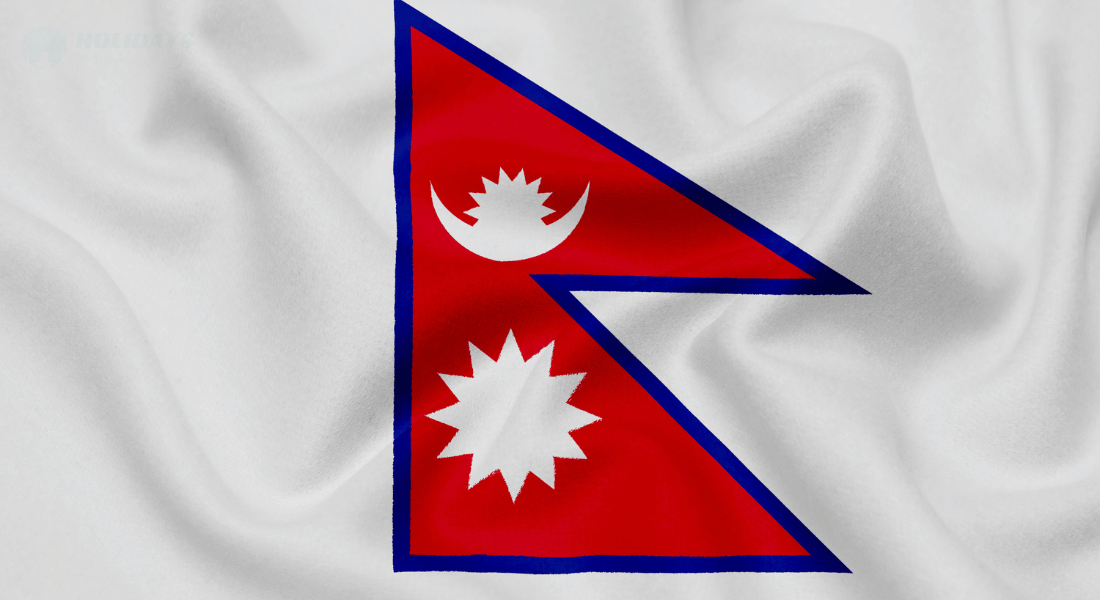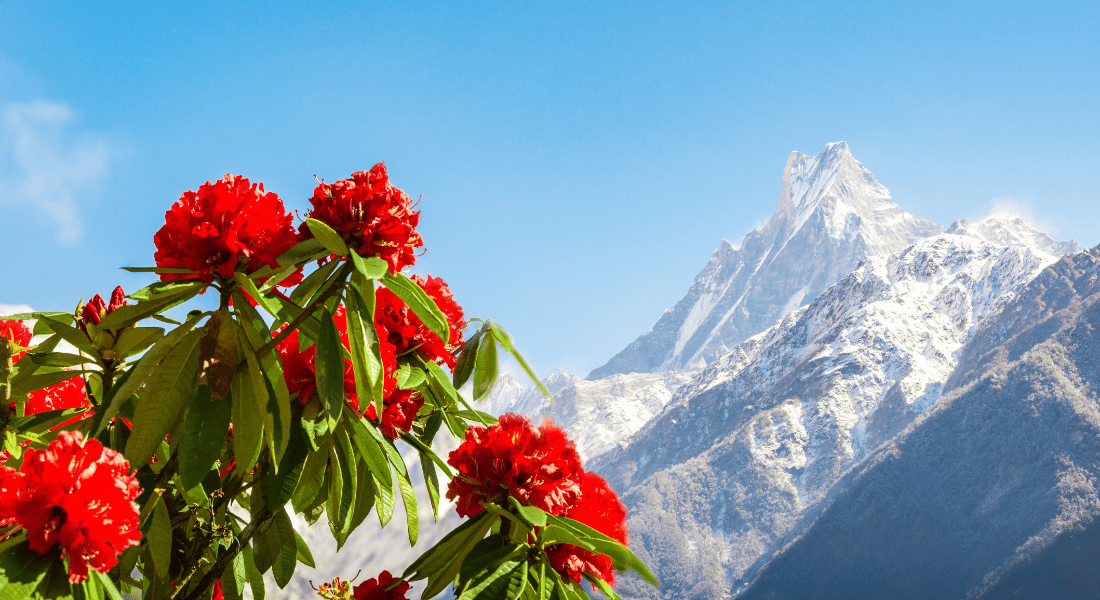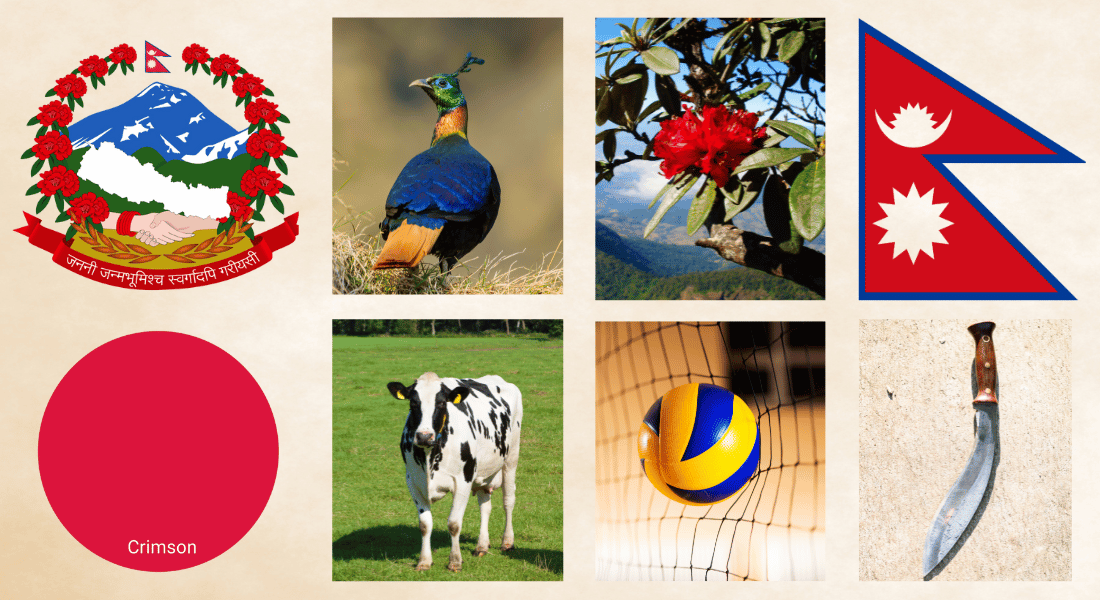Nepal, a country known for its magnificent scenery and rich cultural legacy, has its own set of national symbols that capture the essence of the country's history, customs, and people. These symbols serve as reminders of the ideals and goals that the people of Nepal hold dear, in addition to serving as representations of the country's identity. Every symbol, from the famous flag to the national flower and animal, has deep symbolic implications that link the past and present and provide an insight into the character of this multicultural nation.
Nepal's national symbols represent the harmonious coexistence of the country's natural beauty and rich cultural legacy. By serving as a reminder of their common past and the sacrifices made by those who came before them, they plant a sense of dignity and patriotism in the public. A nation that is both forward-thinking in its goals and proud of its heritage is conveyed by each of its symbols, which range from the iconic flag that honours bravery and peace to the national flower and animal that draw attention to the great biodiversity of the nation.
By promoting a shared national identity and transcending divides, these symbols collectively promote a sense of unity among Nepal's different groups. As they inspire individuals to embrace their shared ideals and objectives, they serve as a reminder of their distinct ancestry. As one explores the national symbols of Nepal, one can gain insight into the heart and soul of a nation that continues to thrive amidst challenges, celebrating its rich cultural legacy while looking towards a brighter future.
Table Of Content
- National Symbols and its Impact on Culture
- List of National Symbols of Nepal
- Nepal National Logo
- Nepal National Flag
- Nepal National Language
- Nepal National Anthem
- Nepal National Weapon
- Nepal National Dress
- Nepal National Food
- Nepal National Flower
- Nepal National Bird
- Nepal National Animal
- Nepal National Sport
- Other Significant Symbols
- Conclusion
- Frequently Asked Questions (FAQs)
National Symbols and its Impact on Culture
National symbols are potent visual and conceptual representations that embody a nation's identity, values, and aspirations. From flags and anthems to animals and plants, these symbols serve as unifying forces, fostering a sense of belonging and pride among citizens. They often draw inspiration from history, geography, or cultural traditions, acting as tangible links to the nation's past and present.
Nepal, a land of diverse cultures and breathtaking landscapes, is rich in symbolism. From the majestic Himalayas to the serene lakes, the country’s natural beauty has inspired many national symbols. The Rhododendron, a vibrant flower, is Nepal’s national flower, representing the country's natural splendour and resilience. Similarly, the Danphe is the national bird, symbolising pride of the nation. The impact of national symbols on culture is profound. They shape public perception, influencing attitudes and behaviours. For instance, the Nepalese flag, with its crimson background and blue border, which represent bravery, peace, and prosperity, respectively. These symbols play a crucial role in education, transmitting cultural heritage to younger generations. While national symbols unify and represent cultural heritage, their impact can be complex and multifaceted.
In a globalised world, where cultures often blend and blur, national symbols act as anchors, grounding a nation in its roots while embracing the future. They inspire patriotism, foster civic engagement, and contribute to the preservation of cultural heritage. By understanding and appreciating the significance of these symbols, one can gain a deeper insight into a nation's soul and its aspirations.
List of National Symbols of Nepal
Here is a list of some of the National Symbols of Nepal:
|
National Symbols |
Name |
|
Nepal National Logo |
Mt. Everest, Green Hills, Mountains, Flag of Nepal, Garland |
|
Nepal National Flag |
Two triangle flag with “Sun” and “Moon” |
|
Nepal National Language |
Nepali |
|
Nepal National Anthem |
Sayaun Thunga (Hundreds of Flowers) |
|
Nepal National Weapon |
Khukuri |
|
Nepal National Dress |
Daura Suruwal and Gunyo Cholo |
|
Nepal National Food |
Dal Bhat (Rice, Curry, and Lentil soup) |
|
Nepal National Flower |
Laliguras (Rhododendron) |
|
Nepal National Bird |
Danphe (Himalayan Monal) |
|
Nepal National Animal |
Cow |
|
Nepal National Sport |
Volleyball |
Nepal National Logo
Nepal's national logo is a deeply symbolic depiction of the nation's identity, culture, and principles. The highest peak in the world, Mount Everest, sits atop the emblem, representing Nepal's pride and breathtaking natural surroundings. The national flower of Nepal, the rhododendron, is arranged in a garland around the mountain to highlight the vast biodiversity of the country. The national flag, which represents unity and national sovereignty, is displayed under Everest in the logo.

In addition, the emblem features the joining hands of a man and a woman signifying both gender parity and harmony between Nepal's many ethnic groups. The Sugauli Treaty's outline of Nepal's territory is depicted on the map in the background. The emblem's base features green hills that represent the country's hilly terrain. The national motto, "जननी जन्पभूमिश्च स्वर्गादपि गरीयसी," is displayed in Sanskrit at the bottom and reads, "Mother and Motherland are greater than Heaven." This motto captures the profound respect that Nepalese people have for their nation and culture, which makes the national emblem a potent representation of pride and cohesion among the people.
Nepal National Flag
Nepal's National flag is unique, being the only non-quadrilateral flag in the world. It is made up of two triangles placed one on top of the other. The national flower, the rhododendron, is the same colour as the background, which is crimson red, representing bravery. The blue border stands for harmony and peace. The white crescent moon with a single star (Chandra) in the upper triangle represents the Himalayas' chilly environment. A white sun (Surya) with twelve rays, symbolising the warmth and resolve of the Nepalese people, is included in the lower triangle.

The flag's design is rich in cultural and historical significance. The two triangles are said to represent the Himalayan mountains and the two major religions of Nepal, Hinduism and Buddhism. The presence of the sun and moon indicates that Nepal's existence will last as long as the longevity of the sun and moon. The unique shape of the flag distinguishes it from all other national flags, reflecting Nepal's independent identity and its rich historical heritage. Officially adopted on December 16, 1962, with the formation of a new constitutional government, the flag’s geometry is precisely defined in the constitution, ensuring its iconic design is preserved. The flag stands as a proud emblem of Nepal's sovereignty, unity, and the enduring spirit of its people.
Learn More: National Flag of Nepal
Nepal National Language
Nepali, also known as Gorkhali, is the official national language of Nepal, deeply rooted in the country's cultural and historical identity. It belongs to the Indo-Aryan branch of the Indo-European language family and evolved from Sanskrit. Written in the Devanagari script, Nepali developed from the ancient language of the Khas people and was promoted as the language of administration and education during the unification of Nepal under King Prithvi Narayan Shah in the 18th century and later during the Rana regime. The language includes a rich vocabulary influenced by Sanskrit, Hindi, Maithili, Tibetan, and more recently, English.

Serving as a unifying medium among Nepal's diverse ethnic groups, Nepali is the primary language for government, education, media, and commerce. It is the language of the national anthem, literature, and various forms of entertainment. Standardised on the Central Nepali dialect, it bridges regional dialects and variations, fostering national unity and identity. Beyond its functional role, Nepali is a vital part of Nepal's cultural heritage, reflecting the nation's literary, poetic, musical, and folkloric traditions, thereby emphasising its significance in the social and cultural fabric of the country.
Nepal National Anthem
The national anthem of Nepal, titled "Sayaun Thunga Phulka Hami," was officially adopted in 2007, replacing the previous anthem. Composed by Pradeep Kumar Rai, popularly known by his pen name Byakul Maila, the anthem's lyrics celebrate the diverse cultures, ethnicities, and natural beauty of Nepal. The phrase "Sayaun Thunga Phulka" translates to "Hundreds of Flowers," symbolising the unity and harmony among the various communities that make up the nation, much like a bouquet of flowers coming together to create a beautiful whole.
Musically, the anthem is composed by Amber Gurung, whose melody adds to the emotional and patriotic essence of the lyrics. The anthem plays a crucial role in instilling national pride and unity among the Nepalese people, often being performed at public events, national celebrations, and ceremonies. For instance, the national anthem is played at official events, schools, and public gatherings, reinforcing national pride and unity among the people. Through its touching words and uplifting tune, "Sayaun Thunga Phulka" emphasises the spirit of freedom, resilience, and collective identity, resonating deeply with the aspirations and sentiments of the Nepalese populace. It serves as a reminder of the country's rich heritage and the shared responsibility of its citizens to uphold the values of peace and unity.
The National Anthem in Nepali Language:
सयौं थुँगा फूलका हामी, एउटै माला नेपाली
सार्वभौम भई फैलिएका, मेची–माहाकाली। (x2)
प्रकृतिका कोटी–कोटी सम्पदाको आंचल
वीरहरूका रगतले, स्वतन्त्र र अटल।
ज्ञानभूमि, शान्तिभूमि तराई, पहाड, हिमाल
अखण्ड यो प्यारो हाम्रो मातृभूमि नेपाल।
बहुल जाति, भाषा, धर्म, संस्कृति छन् विशाल
अग्रगामी राष्ट्र हाम्रो, जय जय नेपाल।
And the English translation of the Nepali National Anthem:
Woven from hundreds of flowers, we are one garland that’s Nepali,
Sovereignly spread across from Mechi to Mahakali.
A shawl of unending natural wealth,
From the blood of the brave, a nation free and immovable.
A land of knowledge, of peace, the plains, hills, and mountains tall,
Indivisible, this beloved land of ours, our motherland Nepal.
Of many races, languages, religions, and cultures of incredible sprawl
This progressive nation of ours, all hail Nepal!
Nepal National Weapon
The national weapon of Nepal is the Khukuri, a traditional curved knife that holds significant cultural and historical importance for the Nepalese people. Recognised for its distinctive shape, with a broad blade that curves inward, the khukuri is not only a weapon but also a versatile tool used for various purposes, including farming, cooking, and household tasks. Its design allows for powerful chopping and cutting motions, making it effective in combat as well.

Historically, the khukuri is associated with the Gurkha soldiers, known for their bravery in battle. The khukuri represents courage, loyalty, and the rich martial heritage of Nepal. In addition to its functional uses, the khukuri is often decorated with intricate designs and is sometimes used in cultural and ceremonial contexts, highlighting its significance as a national symbol of pride and identity
Nepal National Dress
The national dress of Nepal is a representation of the country's rich cultural heritage and diverse traditions. For men, the traditional attire is the Daura Suruwal, while for women, it is the Gunyo Cholo. The Daura Suruwal is more than just everyday attire; it is worn during formal occasions, cultural events, and national celebrations. The design of the Daura is believed to have spiritual significance, with the eight strings and five pleats symbolising different elements of Nepalese mythology and cultural beliefs. The costume is accompanied by a traditional hat called “Dhaka Topi,” making it the perfect Nepalese attire famous among the Brahmin and Chettri communities.

Similarly, Gunyo Cholo varies in style and fabric across different regions and ethnic groups within Nepal, reflecting the country's cultural diversity. Women wear this attire during festivals, weddings, and other significant events, often adorned with traditional jewellery and accessories.
Both the Daura Suruwal and Gunyo Cholo are integral to Nepalese identity, embodying the nation's history, culture, and values. These traditional dresses are cherished symbols of national pride, showcasing the traditionalism and rich cultural heritage of Nepal.
Nepal National Food
The national food of Nepal, Dal Bhat, is a staple dish that embodies the essence of Nepalese cuisine and culture. "Dal" refers to lentil soup, while "Bhat" means steamed rice. Together, they form a balanced and nutritious meal often complemented by various side dishes such as vegetable curries (tarkari), pickles (achar), and sometimes meat or fish. Served on a large metal plate called a "thali”, Dal Bhat is a daily dietary staple for Nepalese people, providing essential nourishment and energy. The dish is known for its versatility and adaptability, incorporating regional ingredients and flavours that reflect the diverse geography of Nepal.

More than just a meal, Dal Bhat holds cultural significance and is a symbol of Nepalese identity and hospitality. It is enjoyed by people from all walks of life, from rural farmers to urban residents, and is a common feature at family meals and communal gatherings. The phrase "Dal Bhat power, 24 hour" humorously highlights its importance in daily life. Dal Bhat's simplicity and the communal way it is shared emphasise the values of unity and togetherness in Nepalese society, making it a cherished national dish that nourishes both body and spirit.
Nepal National Flower
Nepal's national flower, the Rhododendron, natively known as Laliguras, is a significant symbol of the country's natural beauty. The rhododendron blooms in various colours, including red, pink, and white, but it is the red variety that holds special national importance. Found predominantly in the hilly regions of Nepal, especially in the mid-hill and higher altitudes, the rhododendron forests paint the landscape with stunning hues during the blooming season, typically from the months of March and April. The flower's prevalence and appeal have made it a symbol of national pride, representing the natural beauty and rich biodiversity of Nepal.

Beyond its attractive appeal, the Rhododendron plays a crucial role in Nepal's ecology. As a native species, it contributes to biodiversity and soil conservation in the fragile Himalayan ecosystem. Additionally, certain Rhododendron species possess medicinal properties, making them valuable resources as traditional herbs. This national flower represents the natural splendour of Nepal and its connection to the everyday lives and traditions of its people.
Nepal National Bird
Nepal’s National Bird is the majestic Himalyan Monal, locally known as Danphe. The Himalayan Monal is native to the Himalayan region and is found at high altitudes, typically between 2,100 and 4,500 m. It inhabits the dense forests and alpine meadows of Nepal, where it thrives in the cool, mountainous environment. This stunning creature is a symbol of the country's natural beauty and rich biodiversity. This striking bird is renowned for its sparkling plumage, which displays a dazzling array of colours that shimmer in the sunlight. The male Himalayan Monal is particularly eye-catching with its vivid metallic hues of blue, green, red, and gold, while the female, though less colourful, boasts a more subtle but equally beautiful brownish plumage with distinctive patterns.

The bird’s presence in the natural habitats of Nepal also highlights the country’s rich biodiversity and commitment to conservation. The Danphe is not just a symbol but also plays a crucial role in the delicate Himalayan ecosystem. Efforts to protect the Himalayan Monal and its habitat are crucial, as it is one of the endangered species of Nepal.
Nepal National Animal
The national animal of Nepal is the Cow. Cow holds a unique status in Nepal, being both a national animal and a sacred symbol. In Hinduism, which is the predominant religion in Nepal, the cow is considered a sacred animal, symbolising wealth, strength, and motherly love. This reverence is deeply ingrained in Nepalese society, where cows are often associated with the goddess Laxmi, the deity of wealth and prosperity. The respect for cows is evident in various aspects of daily life and religious practices; for instance, the festival of Tihar, also known as the festival of lights, includes a specific day dedicated to worshipping cows, called Gai Tihar.

Apart from its religious significance, the cow plays a vital role in the agrarian lifestyle that sustains much of Nepal's population. Cows are integral to the agricultural economy, providing essential resources such as milk, dung, and labour for ploughing fields. Milk from cows is a staple in the Nepalese diet, used to produce various dairy products like yoghurt, butter, and ghee, which are essential components of traditional cuisine. The cultural and economic importance of the cow is protected by law, with strict regulations against cow slaughter, reflecting the deep respect and value placed on this animal in Nepalese society. The cow, as the national animal of Nepal, symbolises not only religious holiness but also the prosperity it brings to the lives of the Nepalese people.
Nepal National Sport
Volleyball was declared the national sport of Nepal in 2017. This sport is widely played across the country, from the plains of the Terai to the high-altitude villages of the Himalayas. The sport’s accessibility and the relatively low cost of equipment make it an attractive option for many, contributing to its popularity. Various local and national tournaments are held throughout the year, fostering a spirit of competition and community engagement.

In addition to its, volleyball has also been recognised at the international level, with Nepal participating in various regional competitions. The sport has been active in promoting teamwork, discipline, and physical fitness among the youth. Moreover, initiatives by the government and non-governmental organisations to support volleyball development have led to improved training facilities and coaching, which aim to elevate the standard of the game in Nepal. This commitment to enhancing the sport continues to inspire a new generation of players, further solidifying volleyball's status as a beloved national pastime.
Other Significant Symbols
In addition to its flag, emblem, and anthem, Nepal boasts several other significant national symbols that reflect its rich cultural heritage and national identity. These symbols encompass sports, musical instruments, colours, fruits, and currency, each representing unique aspects of Nepal's traditions and values.

-
Nepal's National Musical Instrument: The Madal, a traditional Nepalese drum, is the national musical instrument. It is an integral part of Nepalese music, especially in folk songs and dances. The Madal's rhythmic beats are a staple in festivals and celebrations, symbolising the vibrant cultural tapestry of Nepalese life.
-
Nepal's National Colour: Crimson red is the national colour of Nepal, representing the bravery of the Nepalese people. This colour is prominently featured in the national flag and is associated with various cultural and religious rituals, embodying strength and sacrifice.
-
Nepal's National Fruit: As of 2024, the orange (Citrous sinensis) has been designated as Nepal's national fruit. Cultivated extensively in the hilly regions, oranges are cherished for their sweet and tangy flavour. This fruit not only symbolises the agricultural richness and diversity of Nepal but also highlights the importance of sustainable farming practices in the country’s economy.
-
Nepal's National Currency: The Nepalese Rupee (Nepali: रुपैयाँ; symbol: रु; code: NPR) is the official currency of Nepal. Introduced in 1932, the rupee reflects Nepal’s economic history and development. The currency notes and coins often feature images of national figures, landmarks, and symbols, serving as a daily reminder of Nepal’s heritage and progress.
These national symbols, from sports and musical instruments to colours and currency, each play a vital role in expressing the cultural identity and unity of Nepal. They connect the people to their heritage and promote a sense of national pride and cohesion.
Conclusion
The national symbols of Nepal serve as powerful representations of the country’s rich cultural heritage, diverse history, and the resilience of its people. Each symbol, from the iconic flag to the revered cow, encapsulates the values, beliefs, and aspirations that unite the nation. Together, they form a collective identity that transcends regional differences, fostering a sense of pride and belonging among the diverse ethnic groups that inhabit this beautiful country. Understanding these symbols deepens our appreciation for Nepal and its multifaceted culture, providing insights into the spirit that drives its people.
These symbols are more than just representations; they are the soul of Nepal, carrying the hopes, aspirations, and values of its people. As Nepal continues to navigate the complexities of modernisation and globalisation, these symbols serve as anchors, grounding the nation in its rich traditions while allowing for growth and development.
As one understands these national symbols, they acknowledge their significance in shaping the country’s identity and fostering a sense of national pride. By honouring and understanding these symbols, both locals and visitors can gain a deeper connection to Nepal’s vibrant culture and the enduring spirit of its people. They serve as a reminder of the nation's resilience and its commitment to harmony, inviting us to explore the depths of this Himalayan gem.
Frequently Asked Questions (FAQs)
Here are some frequently asked questions about national symbols of Nepal:
What role do national symbols play in education in Nepal?
National symbols are an integral part of the education system in Nepal. They are taught in schools to instill a sense of pride and understanding of the country’s heritage among students, fostering patriotism and respect for cultural diversity.
How do the national symbols impact tourism in Nepal?
National symbols significantly impact tourism by attracting visitors interested in exploring Nepal’s rich cultural heritage. Tourists often seek to learn about the meanings behind these symbols, enhancing their travel experience and appreciation for the country’s identity.
What role do national symbols play in Nepali festivals and celebrations?
National symbols are often prominently displayed during festivals and national holidays, such as Republic Day and Democracy Day, serving as reminders of the country’s values and heritage. For example, national flags are displayed in street festivals such as Indra Jatra and Bhoto Jatra, where the national anthem is played by the army in front of thousands of people.





